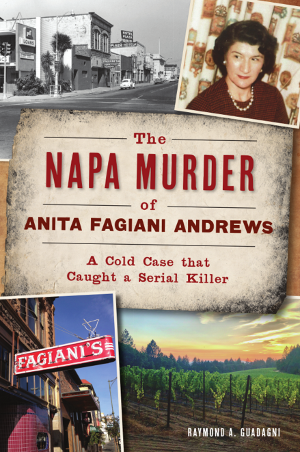
The 1974 murder of Anita Fagiani Andrews shook Napa. After thirty-seven years DNA evidence brought her killer, Roy Melanson to justice.
Most crime junkies know the Texas Defense, made famous by country singer (and murderer!) Ernest Tubb—the claim in court that a murder suspect should be acquitted not because of any evidentiary or procedural matters, but because, quite literally, “the other guy had it comin’.” It’s one of the great plays in the defense attorney’s playbook, and is still used from time to time today.
Roy Melanson & The SODDI Defense
That playbook, however, has many pages. And this week on Crime Capsule, we’re exploring another one of the all-time classics: have you ever heard of SODDI?

July 10, 1974, Napa, California. A small town just north of Bay Area where, fittingly for wine country, most of the crimes committed were bar fights or drunk driving. So for Muriel Fagiani to discover the body of her sister Anita Fagiani Andrews the next day, brutally murdered on the floor of the bar the two of them operated, the shock and horror was felt not just by the Fagiani family, but throughout the whole of Napa as well.
In his book The Napa Murder of Anita Fagiani Andrews: A Cold Case that Caught a Serial Killer, historian and former judge Raymond A. Guadagni tells the story of the search for Andrews’ killer, a thirty-seven year saga that ended in the conviction of Roy Melanson, now known as a serial killer and habitual rapist. It’s a story of early leads, of disappearing evidence (Andrews’ car, mysteriously, was stolen and never found), of red herrings and discarded suspects, and of a case gone cold for decades.
The Evidence
It’s also the story of a single cigarette, which brings us to SODDI. Among the evidence found on scene was a cigarette butt left behind in the bar by the main person of interest in the case (witnesses had seen an unknown man there the day of Andrews’ murder, drinking and smoking alone). Though it wasn’t of much immediate use in 1974, investigators collected it nevertheless. For years, that cigarette remained untouched, until the early 2000s when Detective Don Winegar, who had recently taken on the case, sent it to the DOJ crime lab. Thanks to the advances in DNA testing in the meantime—which also helped to convict Tina Faelz’ killer—the cigarette came back a match.

The match was for Melanson, who was already serving time in Colorado for the murder of hiker Michele Wallace—a murder that took place barely two months after Andrews’. Based on this and other evidence (a bloody towel that also contained traces of his DNA), it wasn’t long before the Napa County DA had Melanson on trial. With Melanson proven to have been in the bar that day, the defense was in a corner, and so out came SODDI. As Guadagni explains,
“The core of the defense case [is] informally referred to in defense circles as the ‘SODDI defense,’ or ‘Some Other Dude Did It.’ That defense rests on the argument that the evidence is insufficient to prove beyond a reasonable doubt that the defendant committed the crime. The SODDI defense is employed in cases where the defense cannot deny that a crime has occurred, such as a homicide. In such a situation, the defense attempts to shift blame onto another unidentified person.”
Guadagni would know—not only was he a judge before he was an author, he was the judge in Andrews’ murder trial. In this case, Melanson’s attorney tried to argue that in between the time that witnesses saw Melanson in the bar, and the time that Andrews’ sister found her, somebody else had shown up and done the deed. Logically, the notion could not be disproved: it wasn’t much, but all the defense had to do was establish a reasonable doubt.

But prosecutors weren’t having any of it, honing in on the cigarette butt and the bloody towel. In DA Paul Gero’s closing arguments—recorded verbatim thanks to trial transcripts—he had this to say to the jury: “Is that reasonable? Sure, it’s possible, but is it reasonable? I don’t think so. It is not reasonable that there’s another man like Mr. Melanson who likes to rape women, likes to murder women and likes to steal cars, and he just happened to come into the same bar after Mr. Melanson leaves. That is completely unreasonable. It is possible, yes. But it is not reasonable.”
The jury agreed, and found Melanson guilty of murder in the first, thirty-seven years after Andrews was killed. The moral of the story? SODDI may work well in some cases, but for this particular serial killer, it turned out to be a pretty shoddy defense in the end.
Looking for more to read during quarantine? Check out our quaran-reads here. Finding us for the first time, and want to learn more about what we do? Visit our welcome page and sign up for the Crime Capsule email newsletter. See you behind bars!
Want to learn more about Anita Fagiani Andrews? Check out the full book!

The Napa Murder of Anita Fagiani Andrews: A Cold Case That Caught a Serial Killer
By Raymond A. Guadagni
In 1974, the brutal murder of Anita Fagiani Andrews, a fifty-one-year-old former beauty queen and mother of two, shook the small working-class town of Napa. Detectives, criminalists and forensic experts raced to identify who’d struck Anita down in her own bar, but despite their efforts, the case went cold. Decades passed, during which the town grew into a world-renowned wine region and tourist destination, but the case remained an open question. After thirty-seven years, thanks to DNA evidence, the killer—imprisoned for a different murder—was finally found and brought to justice. Join author and retired judge Raymond A. Guadagni as he tells the story of the shocking murder, the investigation and the subsequent trial over which he presided in 2011.



